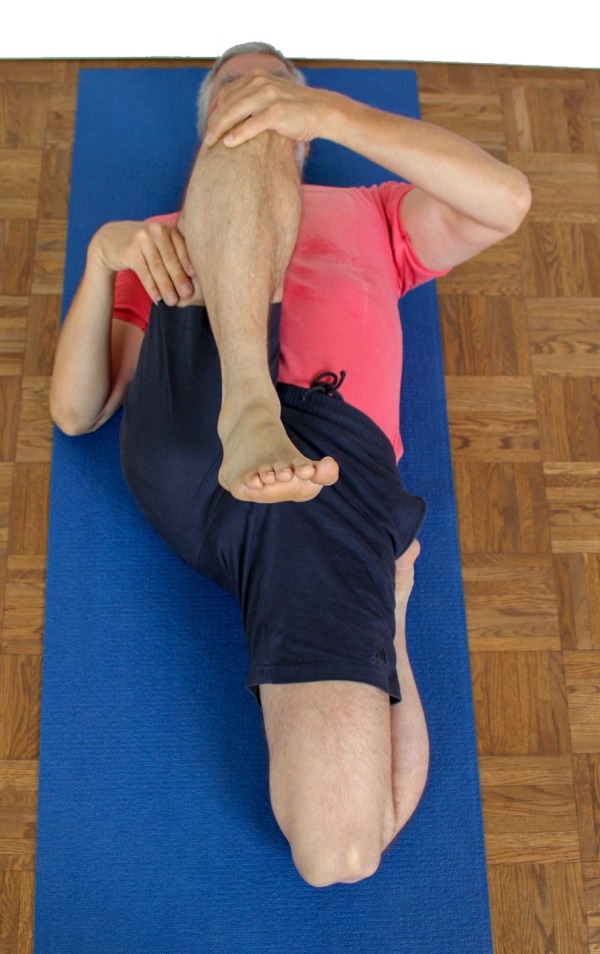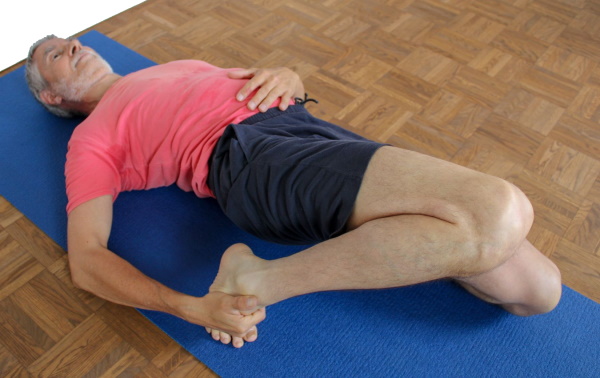yogabook / asanas / ardha supta krouncasana
ardha supta krouncasana
„half lying Reiher“

 instructions and details with working links for download/print
instructions and details with working links for download/print
detail images
Limit lateral evasion |
Feedback: We’d love to hear what you think about this description, give us feedback at:
postmeister@yogabook.org
Last modified: 30.12.2018
Name: ardha supta krouncasana
Trivial name: half lying heron
Level: FA
- classification
- contraindications
- effects
- preparation
- follow-up
- derived asanas
- similar asanas
- diagnostics
- instructions
- details
- variants
Classification
classic: lying pose
physiological: intensive stretching of the rectus femoris muscle
Contraindication
Effects of
- (726) Stretching the short hip extensors
- (811) Stretching the quadriceps
- (816) Stretching the rectus femoris
- (841) Stretching the dorsiflexors
Preparation
As ardha supta krouncasana contains a virasana leg, all stretching preparations for the quadriceps are generally recommended:
In contrast to krouncasana and supta krouncasana, there is no need to prepare an extended leg for the sharp flexion in the hip joint with the knee extended. However, if the hamstrings have good flexibility, short extensors of the hip joint (such as the gluteus maximus and dorsal hip muscles) may restrict flexion in the hip joint. This can be counteracted by :
- half lotus forward bend
- hip opener at the edge of the mat
- hip opener 3
- parivrtta trikonasana
- parivrtta ardha chandrasana
Follow up
Derived asanas:
Similar asanas:
Diagnostics (No.)
(884) Knee:
In this pose, knee problems associated with wide flexion under load (both knees are flexed here, but with different force in each case) are revealed very well. These can be, for example: traumatic or degenerative meniscus damage, arthrosis, subluxations, ligament damage, plica syndromes and others, see the FAQ.
The main reason why a virasana leg might not work and of course the reason for the stretching sensation in that thigh when lifting the other leg with or without a belt is of course the tension of the quadriceps. The flexion of the knee lying on the floor is opposed by the three monoarticular parts and the biarticular rectus femoris opposes the pulling up of the extended leg, as the pelvis is tilted out of flexion in the hip joint when the leg is pulled up.
(648) Tension of the muscles in the lateral lower back:
Although part of the pose build-up involves pushing the buttock of the leg to be pulled towards the chest away from the back to avoid cramping of the lateral lower back, in some cases this tendency to cramp may not completely disappear and indicates high tension, which can also be countered with trunk side bends such as
and forward bends with rotation of the spine, e.g.
Variants:
Instructions
- There are two ways to take this pose: 1. from supta virasana by bringing one leg out of the pose; this is possible for more experienced performers and is the method of choice after practising supta virasana beforehand. 2. the pose can be built up from the seated position in virasana, which is the method of choice for those who are less experienced or less flexible in the quadriceps. The 2nd option is described below as a variation.
- Lie in supta virasana; turn the upper body slightly to the left and bring the right foot out of the pose with the right hand. First place the right foot on the floor near the right buttock
- Bend further in the right hip joint so that the right leg moves closer to the upper body.
- Push the right buttock away from the back.
- Grasp the right knee from above with your left hand and slowly pull it further and further in the direction of the lateral nipple, i.e. downwards and slightly inwards.
Details
- Make sure that the right knee does not move towards the right armpit, but a little further inwards, i.e. as close as possible to the nipple.
- If you take the right leg out of supta virasana, there will probably be a gap between the pelvis and the left foot, so slide the pelvis as close to the left foot as possible. The test of trying to slide a hand between the left foot and the pelvis should be negative. The left knee will probably also move outwards when you take the right knee out of supta virasana. Balance this out again. To prevent the knee from moving outwards, you can practise against and parallel to a wall so that the knee that wants to move outwards is held in position by the wall. But even then, the leg is still abducted by the pelvis rotating in the plane.
- After the leg has been taken out of supta virasana, push the right buttock forwards, otherwise the lower back on the right side will tend to cramp.
- As in supta virasana, turn out the left thigh, i.e. the inner knee towards the ceiling, the outer knee towards the floor and make sure that the ankle stretches as straight as possible.
- This pose is much easier on the back (lumbar spine) than supta virasana. However, it also requires more flexibility. In cases where the tendency of the muscles of the lower back to cramp cannot be controlled well in supta virasana despite great effort on the part of the glutes to limit the hyperlordosis (hollow back), ardha supta krouncasana can be THE alternative exercise IF it is already possible: by pulling on the knee, the pelvis is tilted out of the hollow back using a large lever arm with a fairly moderate amount of force. Naturally, the increased stretching requirement of the rectus femoris of the leg lying on the ground causes the usual evasive movements to become more pronounced: the knee lying on the ground deviates outwards and tends to lift off the ground. In principle, there are muscles to limit both evasive movements: the adductors help to prevent lateral evasions, all hip extensors, especially the gluteus maximus and the biarticular part of the hamstrings, help to prevent the knee from lifting, but depending on the flexibility and intensity of the exercise, it is almost impossible to prevent outward evasions using your own strength.
- There may be a tendency to cramp in the tensor fasciae latae or rectus femoris of the pulled leg.
- This pose is much easier on the back (lumbar spine) than supta virasana. It is not absolutely necessary in all cases that the back can already be placed on the floor; ardha supta krouncasana can often be practised if the back can only be placed on a shoulder rest.
Variations
from virasana
For people with less flexibility in the quadriceps.
Instructions
- Take the right leg out of virasana.
- Lower the upper body as usual for supta virasana, coming onto the elbows first if necessary.
- If possible, lower the upper body and pull on the right knee with the left hand, using a belt if necessary.
Details
- Depending on how flexible the quadriceps are, this method may be the easier way to take the pose.
- The tendency towards a (usually one-sided) hollow back tends to be greater with this way of taking the pose.
Transition to supta virasana

Instructions
- Lie in ardha supta krouncasana with the right leg pulled towards the chest.
- Release the pull on the right knee and place the right foot on the floor.
- Tilt slightly to the left and fold the right leg under.
- Lower the upper body again as best as possible to take supta virasana.
Details
- Depending on how flexible the quadriceps are, it may be difficult to transition from supta virasana to ardha supta krouncasana and back to supta virasana. This is usually due to the fact that the flexion in the knee joint is limited and the body may have to turn significantly to the side so that the hip on the side of the leg that is folded under or to be folded under comes up sufficiently.
(S) Hold the lower leg

Limit the evasive movements
Instructions
- Take the pose as described above. The supporter stands or sits on the side of the leg that remains on the floor and pushes it slowly and carefully inwards, first until the thigh is parallel to the spine again and then towards the floor.
Details
- As the hip joint is a three-dimensionally mobile joint, the leg that remains on the floor wants to move upwards and outwards and turn in in accordance with the muscle tension. The internal rotation will be the least noticeable, mostly an inclination of the foot lying to the side of the pelvis to move away from its position to the side or of the pelvis to move away from the foot. However, the tendency of the thigh and therefore also the knee to lift off the floor and move outwards will be significantly greater. Supporters can easily counteract these two undesirable movements by pushing the leg inwards and then downwards onto the floor. Caution is advised here, as correcting the evasive movement may significantly increase the sensation of stretching! It is also clear that if the knee is pressed back down to the floor, the pelvis might go further into hyperlordosis again via the pull of the hip flexors and their effect on the lumbar spine.
